India
From jeena
This article is about the Republic of India. For other uses, see India (disambiguation).
| Republic of India
Bhārat Gaṇarājya
|
||||||
|---|---|---|---|---|---|---|
|
||||||
| Motto: "Satyameva Jayate" (Sanskrit) "Truth Alone Triumphs"[1] |
||||||
| Anthem:
Jana Gana Mana "Thou Art the Ruler of the Minds of All People"[2] |
||||||
| National song:
Vande Mataram "I Bow to Thee, Mother"[a][1] |
||||||
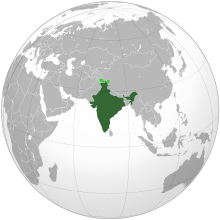
Area controlled by India is in dark green.
Claimed but uncontrolled regions are in light green. |
||||||
| Capital | New Delhi 28°36.8′N 77°12.5′E |
|||||
| Largest city | Mumbai | |||||
| Official language(s) | ||||||
| Recognised regional languages | ||||||
| National language(s) | none[3] | |||||
| Demonym | Indian | |||||
| Government | Federal parliamentary constitutional republic[1] |
|||||
| - | President | Pranab Mukherjee | ||||
| - | Vice President | Mohammad Hamid Ansari | ||||
| - | Prime Minister | Manmohan Singh (INC) | ||||
| - | Speaker of the House | Meira Kumar (INC) | ||||
| - | Chief Justice | S. H. Kapadia | ||||
| Legislature | Parliament of India | |||||
| - | Upper house | Rajya Sabha | ||||
| - | Lower house | Lok Sabha | ||||
| Independence | from the United Kingdom | |||||
| - | Dominion | 15 August 1947 | ||||
| - | Republic | 26 January 1950 | ||||
| Area | ||||||
| - | Total | 3,287,263 km2 [b](7th) 1,269,219 sq mi |
||||
| - | Water (%) | 9.56 | ||||
| Population | ||||||
| - | 2011 census | 1,210,193,422[4] (2nd) | ||||
| - | Density | 370.1/km2 (31st) 958.5/sq mi |
||||
| GDP (PPP) | 2011 estimate | |||||
| - | Total | $4.457 trillion[5] (3rd) | ||||
| - | Per capita | $3,693[5] (129th) | ||||
| GDP (nominal) | 2011 estimate | |||||
| - | Total | $1.848 trillion[6] (10th) | ||||
| - | Per capita | $1,388[5] (140th) | ||||
| Gini (2004) | 36.8[7] (79th) | |||||
| HDI (2011) | ||||||
| Currency | Indian rupee (INR) |
|||||
| Time zone | IST (UTC+05:30) | |||||
| - | Summer (DST) | not observed (UTC+05:30) | ||||
| Date formats | dd-mm-yyyy (AD) | |||||
| Drives on the | left | |||||
| ISO 3166 code | IN | |||||
| Internet TLD | .in | |||||
| Calling code | 91 | |||||
Home to the ancient Indus Valley Civilisation and a region of historic trade routes and vast empires, the Indian subcontinent was identified with its commercial and cultural wealth for much of its long history.[9] Four of the world's major religions—Hinduism, Buddhism, Jainism, and Sikhism—originated here, whereas Zoroastrianism, Christianity, and Islam arrived in the 1st millennium CE and also helped shape the region's diverse culture. Gradually annexed by and brought under the administration of the British East India Company from the early 18th century and administered directly by the United Kingdom from the mid-19th century, India became an independent nation in 1947 after a struggle for independence that was marked by non-violent resistance led by Mahatma Gandhi.
According to World Bank, the Indian economy is the world's tenth-largest by nominal GDP[6] and third-largest by purchasing power parity (PPP). Following market-based economic reforms in 1991, India became one of the fastest-growing major economies; it is considered a newly industrialised country. However, it continues to face the challenges of poverty, illiteracy, corruption, malnutrition, and inadequate public healthcare. A nuclear weapons state and a regional power, it has the third-largest standing army in the world and ranks ninth in military expenditure among nations. India is a federal constitutional republic governed under a parliamentary system consisting of 28 states and 7 union territories. India is a pluralistic, multilingual, and multiethnic society. It is also home to a diversity of wildlife in a variety of protected habitats.
Contents
|
Etymology
Main article: Names of India
The name India is derived from Indus, which originates from the Old Persian word Hindu. The latter term stems from the Sanskrit word Sindhu, which was the historical local appellation for the Indus River.[10] The ancient Greeks referred to the Indians as Indoi (Ινδοί), which translates as "the people of the Indus".[11] The geographical term Bharat (pronounced [ˈbʱaːrət̪] (History
Main articles: History of India and History of the Republic of India
Ancient India
The earliest anatomically modern human remains found in South Asia date from approximately 30,000 years ago.[15] Nearly contemporaneous Mesolithic rock art sites have been found in many parts of the Indian subcontinent, including at the Bhimbetka rock shelters in Madhya Pradesh.[16] Around 7000 BCE, the first known Neolithic settlements appeared on the subcontinent in Mehrgarh and other sites in western Pakistan.[17] These gradually developed into the Indus Valley Civilisation,[18] the first urban culture in South Asia;[19] it flourished during 2500–1900 BCE in Pakistan and western India.[20] Centred around cities such as Mohenjo-daro, Harappa, Dholavira, and Kalibangan, and relying on varied forms of subsistence, the civilisation engaged robustly in crafts production and wide-ranging trade.[19]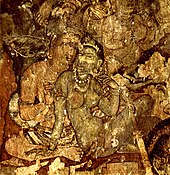
In the late Vedic period, around the 5th century BCE, the small chiefdoms of the Ganges Plain and the north-western regions had consolidated into 16 major oligarchies and monarchies that were known as the mahajanapadas.[28][29] The emerging urbanisation and the orthodoxies of this age also created the religious reform movements of Buddhism and Jainism,[30] both of which became independent religions.[31] Buddhism, based on the teachings of Gautama Buddha attracted followers from all social classes excepting the middle class; chronicling the life of the Buddha was central to the beginnings of recorded history in India.[30][32][33] Jainism came into prominence around the same time during the life of its exemplar, Mahavira.[34] In an age of increasing urban wealth, both religions held up renunciation as an ideal,[35] and both established long-lasting monasteries.[28] Politically, by the 3rd century BCE, the kingdom of Magadha had annexed or reduced other states to emerge as the Mauryan Empire.[28] The empire was once thought to have controlled most of the subcontinent excepting the far south, but its core regions are now thought to have been separated by large autonomous areas.[36][37] The Mauryan kings are known as much for their empire-building and determined management of public life as for Ashoka's renunciation of militarism and far-flung advocacy of the Buddhist dhamma.[38][39]
The Sangam literature of the Tamil language reveals that, between 200 BCE and 200 CE, the southern peninsula was being ruled by the Cheras, the Cholas, and the Pandyas, dynasties that traded extensively with the Roman Empire and with West and South-East Asia.[40][41] In North India, Hinduism asserted patriarchal control within the family, leading to increased subordination of women.[42][28] By the 4th and 5th centuries, the Gupta Empire had created in the greater Ganges Plain a complex system of administration and taxation that became a model for later Indian kingdoms.[43][44] Under the Guptas, a renewed Hinduism based on devotion rather than the management of ritual began to assert itself.[45] The renewal was reflected in a flowering of sculpture and architecture, which found patrons among an urban elite.[44] Classical Sanskrit literature flowered as well, and Indian science, astronomy, medicine, and mathematics made significant advances.[44]
Medieval India

In the 6th and 7th centuries, the first devotional hymns were created in the Tamil language.[49] They were imitated all over India and led to both the resurgence of Hinduism and the development of all modern languages of the subcontinent.[49] Indian royalty, big and small, and the temples they patronised, drew citizens in great numbers to the capital cities, which became economic hubs as well.[50] Temple towns of various sizes began to appear everywhere as India underwent another urbanisation.[50] By the 8th and 9th centuries, the effects were felt in South-East Asia, as South Indian culture and political systems were exported to lands that became part of modern-day Thailand, Laos, Cambodia, Vietnam, Malaysia, and Java.[51] Indian merchants, scholars, and sometimes armies were involved in this transmission; South-East Asians took the initiative as well, with many sojourning in Indian seminaries and translating Buddhist and Hindu texts into their languages.[51]
After the 10th century, Muslim Central Asian nomadic clans, using swift-horse cavalry and raising vast armies united by ethnicity and religion, repeatedly overran South Asia's north-western plains, leading eventually to the establishment of the Islamic Delhi Sultanate in 1206.[52] The sultanate was to control much of North India, and to make many forays into South India. Although at first disruptive for the Indian elites, the sultanate largely left its vast non-Muslim subject population to its own laws and customs.[53][54] By repeatedly repulsing Mongol raiders in the 13th century, the sultanate saved India from the devastation visited on West and Central Asia, setting the scene for centuries of migration of fleeing soldiers, learned men, mystics, traders, artists, and artisans from that region into the subcontinent, thereby creating a syncretic Indo-Islamic culture in the north.[55][56] The sultanate's raiding and weakening of the regional kingdoms of South India paved the way for the indigenous Vijayanagara Empire.[57] Embracing a strong Shaivite tradition and building upon the military technology of the sultanate, the empire came to control much of peninsular India,[58] and was to influence South Indian society for long afterwards.[57]
Early modern India

By the early 18th century, with the lines between commercial and political dominance being increasingly blurred, a number of European trading companies, including the English East India Company, had established coastal outposts.[70][71] The East India Company's control of the seas, greater resources, and more advanced military training and technology led it to increasingly flex its military muscle and caused it to become attractive to a portion of the Indian elite; both these factors were crucial in allowing the Company to gain control over the Bengal region by 1765 and sideline the other European companies.[72][70][73][74] Its further access to the riches of Bengal and the subsequent increased strength and size of its army enabled it to annex or subdue most of India by the 1820s.[75] India was now no longer exporting manufactured goods as it long had, but was instead supplying the British empire with raw materials, and many historians consider this to be the onset of India's colonial period.[70] By this time, with its economic power severely curtailed by the British parliament and itself effectively made an arm of British administration, the Company began to more consciously enter non-economic arenas such as education, social reform, and culture.[76]
Modern India
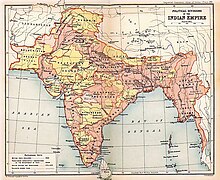

Vital to India's self-image as an independent nation was its constitution, completed in 1950, which put in place a sovereign, secular, and democratic republic.[98] In the 60 years since, India has had a mixed bag of successes and failures.[99] It has remained a democracy with civil liberties, an activist Supreme Court, and a largely independent press.[99] Economic liberalisation, which was begun in the 1990s, has created a large urban middle class, transformed India into one of the world's fastest-growing economies,[100] and increased its geopolitical clout. Indian movies, music, and spiritual teachings play an increasing role in global culture.[99] Yet, India has also been weighed down by seemingly unyielding poverty, both rural and urban;[99] by religious and caste-related violence;[101] by Maoist-inspired Naxalite insurgencies;[102] and by separatism in Jammu and Kashmir.[103] It has unresolved territorial disputes with China, which escalated into the Sino-Indian War of 1962;[104] and with Pakistan, which flared into wars fought in 1947, 1965, 1971, and 1999.[104] The India–Pakistan nuclear rivalry came to a head in 1998.[105] India's sustained democratic freedoms are unique among the world's new nations; however, in spite of its recent economic successes, freedom from want for its disadvantaged population remains a goal yet to be achieved.[106]
Geography
Main article: Geography of India
See also: Geology of India
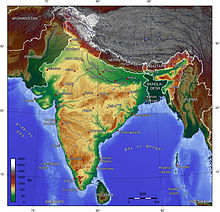
The original Indian plate survives as peninsular India, which is the oldest and geologically most stable part of India; it extends as far north as the Satpura and Vindhya ranges in central India. These parallel chains run from the Arabian Sea coast in Gujarat in the west to the coal-rich Chota Nagpur Plateau in Jharkhand in the east.[111] To the south, the remaining peninsular landmass, the Deccan Plateau, is flanked on the west and east by coastal ranges known as the Western and Eastern Ghats;[112] the plateau contains the nation's oldest rock formations, some of them over one billion years old. Constituted in such fashion, India lies to the north of the equator between 6° 44' and 35° 30' north latitude[e] and 68° 7' and 97° 25' east longitude.[113]

Major Himalayan-origin rivers that substantially flow through India include the Ganges and the Brahmaputra, both of which drain into the Bay of Bengal.[115] Important tributaries of the Ganges include the Yamuna and the Kosi; the latter's extremely low gradient often leads to severe floods and course changes.[116] Major peninsular rivers, whose steeper gradients prevent their waters from flooding, include the Godavari, the Mahanadi, the Kaveri, and the Krishna, which also drain into the Bay of Bengal;[117] and the Narmada and the Tapti, which drain into the Arabian Sea.[118] Coastal features include the marshy Rann of Kutch of western India and the alluvial Sundarbans delta of eastern India; the latter is shared with Bangladesh.[119] India has two archipelagos: the Lakshadweep, coral atolls off India's south-western coast; and the Andaman and Nicobar Islands, a volcanic chain in the Andaman Sea.[120]
The Indian climate is strongly influenced by the Himalayas and the Thar Desert, both of which drive the economically and culturally pivotal summer and winter monsoons.[121] The Himalayas prevent cold Central Asian katabatic winds from blowing in, keeping the bulk of the Indian subcontinent warmer than most locations at similar latitudes.[122][123] The Thar Desert plays a crucial role in attracting the moisture-laden south-west summer monsoon winds that, between June and October, provide the majority of India's rainfall.[121] Four major climatic groupings predominate in India: tropical wet, tropical dry, subtropical humid, and montane.[124]
Biodiversity
Main article: Wildlife of India
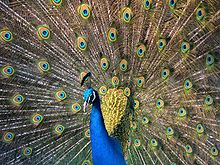

The pervasive and ecologically devastating human encroachment of recent decades has critically endangered Indian wildlife. In response the system of national parks and protected areas, first established in 1935, was substantially expanded. In 1972, India enacted the Wildlife Protection Act[135] and Project Tiger to safeguard crucial wilderness; the Forest Conservation Act was enacted in 1980 and amendments added in 1988.[136] India hosts more than five hundred wildlife sanctuaries and thirteen biosphere reserves,[137] four of which are part of the World Network of Biosphere Reserves; twenty-five wetlands are registered under the Ramsar Convention.[138]
Politics
Main article: Politics of India

In the Republic of India's first three general elections, in 1951, 1957, and 1962, the Jawaharlal Nehru-led Congress won easy victories. On Nehru's death in 1964, Lal Bahadur Shastri briefly became prime minister; he was succeeded, after his own unexpected death in 1966, by Indira Gandhi, who went on to lead the Congress to election victories in 1967 and 1971. Following public discontent with the state of emergency she declared in 1975, the Congress was voted out of power in 1977; the then-new Janata Party, which had opposed the emergency, was voted in. Its government lasted just over three years. Voted back into power in 1980, the Congress saw a change in leadership in 1984, when Indira Gandhi was assassinated; she was succeeded by her son Rajiv Gandhi, who won an easy victory in the general elections later that year. The Congress was voted out again in 1989 when a National Front coalition, led by the newly formed Janata Dal in alliance with the Left Front, won the elections; that government too proved relatively short-lived: it lasted just under two years.[144] Elections were held again in 1991; no party won an absolute majority. But the Congress, as the largest single party, was able to form a minority government led by P. V. Narasimha Rao.[145]
A two-year period of political turmoil followed the general election of 1996. Several short-lived alliances shared power at the centre. The BJP formed a government briefly in 1996; it was followed by two comparatively long-lasting United Front coalitions, which depended on external support. In 1998, the BJP was able to form a successful coalition, the National Democratic Alliance (NDA). Led by Atal Bihari Vajpayee, the NDA became the first non-Congress, coalition government to complete a five-year term.[146] In the 2004 Indian general elections, again no party won an absolute majority, but the Congress emerged as the largest single party, forming another successful coalition: the United Progressive Alliance (UPA). It had the support of left-leaning parties and MPs who opposed the BJP. The UPA returned to power in the 2009 general election with increased numbers, and it no longer required external support from India's communist parties.[147] That year, Manmohan Singh became the first prime minister since Jawaharlal Nehru in 1957 and 1962 to be re-elected to a consecutive five-year term.[148]
Government
Main article: Government of India
See also: Elections in India

| Flag | Tricolour |
| Emblem | Sarnath Lion Capital |
| Anthem | Jana Gana Mana |
| Song | Vande Mataram |
| Calendar | Saka |
| Game | none [154] |
| Flower | Lotus |
| Fruit | Mango |
| Tree | Banyan |
| Bird | Indian Peafowl |
| Land animal | Royal Bengal Tiger |
| Aquatic animal | River Dolphin |
| River | Ganga (Ganges) |
- Executive: The President of India is the head of state[155] and is elected indirectly by a national electoral college[156] for a five-year term.[157] The Prime Minister of India is the head of government and exercises most executive power.[158] Appointed by the president,[159] the prime minister is by convention supported by the party or political alliance holding the majority of seats in the lower house of parliament.[158] The executive branch of the Indian government consists of the president, the vice-president, and the Council of Ministers—the cabinet being its executive committee—headed by the prime minister. Any minister holding a portfolio must be a member of one of the houses of parliament.[155] In the Indian parliamentary system, the executive is subordinate to the legislature; the prime minister and his council directly responsible to the lower house of the parliament.[160]
- Legislative: The legislature of India is the bicameral parliament. It operates under a Westminster-style parliamentary system and comprises the upper house called the Rajya Sabha ("Council of States") and the lower called the Lok Sabha ("House of the People").[161] The Rajya Sabha is a permanent body that has 245 members who serve in staggered six-year terms.[162] Most are elected indirectly by the state and territorial legislatures in numbers proportional to their state's share of the national population.[159] All but two of the Lok Sabha's 545 members are directly elected by popular vote; they represent individual constituencies via five-year terms.[163] The remaining two members are nominated by the president from among the Anglo-Indian community, in case the president decides that they are not adequately represented.[164]
- Judicial: India has a unitary three-tier independent judiciary[165] that comprises the Supreme Court, headed by the Chief Justice of India, 21 High Courts, and a large number of trial courts.[165] The Supreme Court has original jurisdiction over cases involving fundamental rights and over disputes between states and the centre; it has appellate jurisdiction over the High Courts.[166] It has the power both to declare the law and to strike down union or state laws which contravene the constitution.[167] The Supreme Court is also the ultimate interpreter of the constitution.[168]
Subdivisions

Main article: Administrative divisions of India
See also: Political integration of India
India is a federation composed of 28 states and 7 union territories.[169] All states, as well as the union territories of Pondicherry and the National Capital Territory of Delhi,
have elected legislatures and governments, both patterned on the
Westminster model. The remaining five union territories are directly
ruled by the centre through appointed administrators. In 1956, under the
States Reorganisation Act, states were reorganised on a linguistic basis.[170]
Since then, their structure has remained largely unchanged. Each state
or union territory is further divided into administrative districts. The districts in turn are further divided into tehsils and ultimately into villages.States
|
|
|
|
|
Foreign relations and military
Main articles: Foreign relations of India and Indian Armed Forces
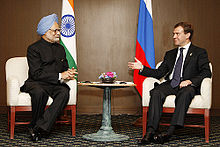
Aside from ongoing strategic relations with Russia, India has wide-ranging defence relations with Israel and France. In recent years, it has played key roles in the South Asian Association for Regional Cooperation and the World Trade Organisation. The nation has provided 100,000 military and police personnel to serve in 35 UN peacekeeping operations across four continents. It participates in the East Asia Summit, the G8+5, and other multilateral forums.[174] India has close economic ties with South America, Asia, and Africa; it pursues a "Look East" policy that seeks to strengthen partnerships with the ASEAN nations, Japan, and South Korea that revolve around many issues, but especially those involving economic investment and regional security.[175][176]

Since the end of the Cold War, India has increased its economic, strategic, and military cooperation with the United States and the European Union.[183] In 2008, a civilian nuclear agreement was signed between India and the United States. Although India possessed nuclear weapons at the time and was not party to the Nuclear Non-Proliferation Treaty, it received waivers from the International Atomic Energy Agency and the Nuclear Suppliers Group, ending earlier restrictions on India's nuclear technology and commerce. As a consequence, India became the sixth de facto nuclear weapons state.[184] India subsequently signed cooperation agreements involving civilian nuclear energy with Russia,[185] France,[186] the United Kingdom,[187] and Canada.[188]
The President of India is the supreme commander of the nation's armed forces; with 1.6 million active troops, they compose the world's third-largest military.[189] It comprises the Indian Army, the Indian Navy, and the Indian Air Force; auxiliary organisations include the Strategic Forces Command and three paramilitary groups: the Assam Rifles, the Special Frontier Force, and the Indian Coast Guard.[7] The official Indian defence budget for 2011 was US$36.03 billion, or 1.83% of GDP.[190] For the fiscal year spanning 2012–2013, US$40.44 billion was budgeted.[191] According to a 2008 SIPRI report, India's annual military expenditure in terms of purchasing power stood at US$72.7 billion,[192] In 2011, the annual defence budget increased by 11.6%,[193] although this does not include funds that reach the military through other branches of government.[194] As of 2012, India is the world's largest arms importer; between 2007 and 2011, it accounted for 10% of funds spent on international arms purchases.[195] Much of the military expenditure was focused on defence against Pakistan and countering growing Chinese influence in the Indian Ocean.[193]
Economy
Main article: Economy of India
See also: Economic history of India, Economic development in India, and Transport in India

The 487.6-million worker Indian labour force is the world's second-largest.[7] The service sector makes up 55.6% of GDP, the industrial sector 26.3% and the agricultural sector 18.1%. Major agricultural products include rice, wheat, oilseed, cotton, jute, tea, sugarcane, and potatoes.[169] Major industries include textiles, telecommunications, chemicals, food processing, steel, transport equipment, cement, mining, petroleum, machinery, and software.[169] In 2006, the share of external trade in India's GDP stood at 24%, up from 6% in 1985.[201] In 2008, India's share of world trade was 1.68%;[205] In 2011, India was the world's tenth-largest importer and the nineteenth-largest exporter.[206] Major exports include petroleum products, textile goods, jewelry, software, engineering goods, chemicals, and leather manufactures.[169] Major imports include crude oil, machinery, gems, fertiliser, and chemicals.[169] Between 2001 and 2011, the contribution of petrochemical and engineering goods to total exports grew from 14% to 42%.[207]

Despite impressive economic growth during recent decades, India continues to face socio-economic challenges. India contains the largest concentration of people living below the World Bank's international poverty line of US$1.25 per day,[217] the proportion having decreased from 60% in 1981 to 42% in 2005.[218] Half of the children in India are underweight,[219] and 46% of children under the age of three suffer from malnutrition.[217] The Mid-Day Meal Scheme attempts to lower these rates.[220] Since 1991, economic inequality between India's states has consistently grown: the per-capita net state domestic product of the richest states in 2007 was 3.2 times that of the poorest.[221] Corruption in India is perceived to have increased significantly,[222] with one report estimating the illegal capital flows since independence to be US$462 billion.[223] Driven by growth, India's nominal GDP per capita has steadily increased from US$329 in 1991, when economic liberalisation began, to US$1,265 in 2010, and is estimated to increase to US$2,110 by 2016; however, it has always remained lower than those of other Asian developing countries such as Indonesia, Iran, Malaysia, Philippines, Sri Lanka, and Thailand, and is expected to remain so in the near future.[224]
According to a 2011 PricewaterhouseCoopers report, India's GDP at purchasing power parity could overtake that of the United States by 2045.[225] During the next four decades, Indian GDP is expected to grow at an annualised average of 8%, making it potentially the world's fastest-growing major economy until 2050.[225] The report highlights key growth factors: a young and rapidly growing working-age population; growth in the manufacturing sector due to rising education and engineering skill levels; and sustained growth of the consumer market driven by a rapidly growing middle class.[225] The World Bank cautions that, for India to achieve its economic potential, it must continue to focus on public sector reform, transport infrastructure, agricultural and rural development, removal of labour regulations, education, energy security, and public health and nutrition.[226]
As per a report by Datamonitor, India is expected to occupy sixth place in top 10 wealth markets list by the end of 2012.[227]
Citing persistent inflation pressures, weak public finances, limited progress on fiscal consolidation and ineffectiveness of the government, rating agency Fitch revised India's Outlook to Negative from Stable on 18 June 2012.[228] Another credit rating agency S&P had warned previously that a slowing GDP growth and political roadblocks to economic policy-making could put India at the risk of losing its investment grade rating.[229] However, Moody didn't revise its outlook on India keeping it stable[230], but termed the national government as the "single biggest drag" on the business activity.[231]
Demographics
Main article: Demographics of India
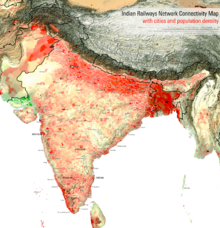

Culture
Main article: Culture of India

Art and architecture
Much of Indian architecture, including the Taj Mahal, other works of Mughal architecture, and South Indian architecture, blends ancient local traditions with imported styles.[255] Vernacular architecture is also highly regional in it flavours. Vastu shastra, literally "science of construction" or "architecture" and ascribed to Mamuni Mayan,[256] explores how the laws of nature affect human dwellings;[257] it employs precise geometry and directional alignments to reflect perceived cosmic constructs.[258] As applied in Hindu temple architecture, it is influenced by the Shilpa Shastras, a series of foundational texts whose basic mythological form is the Vastu-Purusha mandala, a square that embodied the "absolute".[259] The Taj Mahal, built in Agra between 1631 and 1648 by orders of Emperor Shah Jahan in memory of his wife, has been described in the UNESCO World Heritage List as "the jewel of Muslim art in India and one of the universally admired masterpieces of the world's heritage."[260] Indo-Saracenic Revival architecture, developed by the British in the late 19th century, drew on Indo-Islamic architecture.[261]Literature
The earliest literary writings in India, composed between 1400 BCE and 1200 CE, were in the Sanskrit language.[262][263] Prominent works of this Sanskrit literature include epics such as the Mahābhārata and the Ramayana, the dramas of Kālidāsa such as the Abhijñānaśākuntalam (The Recognition of Śakuntalā), and poetry such as the Mahākāvya.[264][265][266] Developed between 600 BCE and 300 CE in South India, the Sangam literature, consisting of 2,381 poems, is regarded as a predecessor of Tamil literature.[267][268][269][270] From the 14th to the 18th centuries, India's literary traditions went through a period of drastic change because of the emergence of devotional poets such as Kabīr, Tulsīdās, and Guru Nānak. This period was characterised by a varied and wide spectrum of thought and expression; as a consequence, medieval Indian literary works differed significantly from classical traditions.[271] In the 19th century, Indian writers took a new interest in social questions and psychological descriptions. In the 20th century, Indian literature was influenced by the works of Bengali poet and novelist Rabindranath Tagore.[272]Performing arts
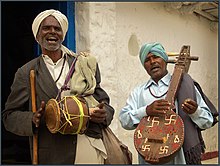
Theatre in India melds music, dance, and improvised or written dialogue.[275] Often based on Hindu mythology, but also borrowing from medieval romances or social and political events, Indian theatre includes the bhavai of Gujarat, the jatra of West Bengal, the nautanki and ramlila of North India, tamasha of Maharashtra, burrakatha of Andhra Pradesh, terukkuttu of Tamil Nadu, and the yakshagana of Karnataka.[276] The Indian film industry produces the world's most-watched cinema.[277] Established regional cinematic traditions exist in the Assamese, Bengali, Hindi, Kannada, Malayalam, Marathi, Oriya, Tamil, and Telugu languages.[278] South Indian cinema attracts more than 75% of national film revenue.[279]
Society
Many Indian festivals are religious in origin; among them are Diwali, Ganesh Chaturthi, Thai Pongal, Navaratri, Holi, Durga Puja, Eid ul-Fitr, Bakr-Id, Christmas, and Vaisakhi. India has three national holidays which are observed in all states and union territories: Republic Day, Independence Day, and Gandhi Jayanti. Other sets of holidays, varying between nine and twelve, are officially observed in individual states. Traditional Indian dress varies in colour and style across regions and depends on various factors, including climate and faith. Popular styles of dress include draped garments such as the sari for women and the dhoti or lungi for men. Stitched clothes, such as the shalwar kameez for women and kurta–pyjama combinations or European-style trousers and shirts for men, are also popular.[287] Use of delicate jewellery, modelled on real flowers worn in ancient India, is part of a tradition dating back some 5,000 years; gemstones are also worn in India as talismans.[288]
Indian cuisine features an unsurpassed reliance on herbs and spices, with dishes often calling for the nuanced usage of a dozen or more condiments;[289] it is also known for its tandoori preparations. The tandoor, a clay oven used in India for almost 5,000 years, grills meats to an "uncommon succulence" and produces the puffy flatbread known as naan.[290] The staple foods are wheat (predominantly in the north),[291] rice (especially in the south and the east), and lentils.[292] Many spices that have worldwide appeal are native to the Indian subcontinent,[293] while chili pepper, native to the Americas and introduced by the Portuguese, is widely used by Indians.[294] Āyurveda, a system of traditional medicine, used six rasas and three guṇas to help describe comestibles.[295] Over time, as Vedic animal sacrifices were supplanted by the notion of sacred-cow inviolability, vegetarianism became associated with high religious status and grew increasingly popular,[296] a trend aided by the rise of Buddhist, Jain, and bhakti Hindu norms.[297] India has the world's highest concentration of vegetarians: a 2006 survey found that 31% of Indians were non-ovo vegetarian.[297] Common traditional eating customs include meals taken on or near the floor, caste- and gender-segregated dining,[298][299] and a lack of cutlery in favour of the right hand or a piece of roti.
Sport
Main article: Sport in India

Field hockey in India is administered by Hockey India. The Indian national hockey team won the 1975 Hockey World Cup and have, as of 2012, taken eight gold, one silver, and two bronze Olympic medals, making it the sport's most successful team. India has also played a major role in popularizing Cricket, thus cricket is by far the most popular sport of India; the Indian national cricket team won the 1983 and 2011 Cricket World Cup events, the 2007 ICC World Twenty20, and shared the 2002 ICC Champions Trophy with Sri Lanka. Cricket in India is administered by the Board of Control for Cricket in India, or BCCI; the Ranji Trophy, the Duleep Trophy, the Deodhar Trophy, the Irani Trophy, and the NKP Salve Challenger Trophy are domestic competitions. The BCCI conducts a Twenty20 competition known as the Indian Premier League. India has hosted or co-hosted several international sporting events: the 1951 and 1982 Asian Games; the 1987, 1996, and 2011 Cricket World Cup tournaments; the 2003 Afro-Asian Games; the 2006 ICC Champions Trophy; the 2010 Hockey World Cup; and the 2010 Commonwealth Games. Major international sporting events held annually in India include the Chennai Open, the Mumbai Marathon, the Delhi Half Marathon, and the Indian Masters. The first Indian Grand Prix featured in late 2011.[310] India has traditionally been the dominant country at the South Asian Games. An example of this dominance is the basketball competition where Team India won three out of four tournaments to date.[311]




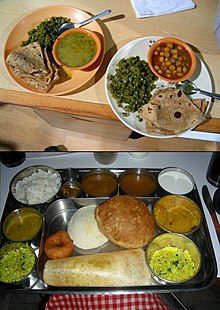
No comments:
Post a Comment